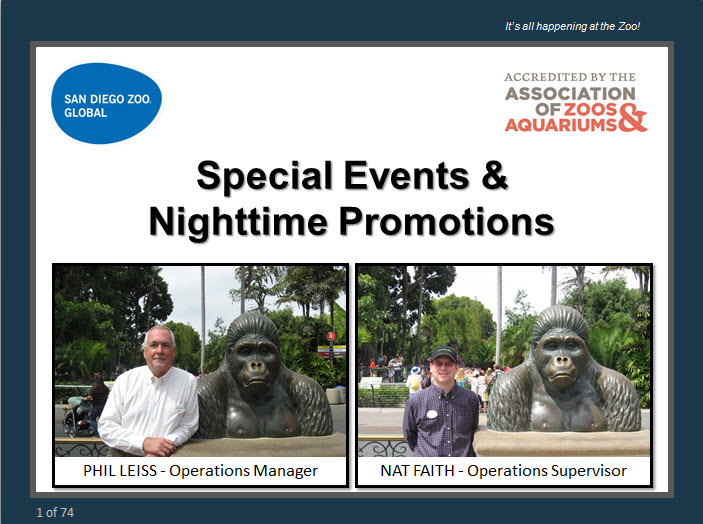 |
Special Events & Nighttime Promotions |
1.00 |
In support of San Diego Zoo Global's mission and vision, the Special Event and Nighttime Operations Department is dedicated to providing the highest quality guest enhancements, entertainment, personal service and professional programs to our external and internal customers. These products are intended to increase attendance, support our membership program and promote repeat visits. The department consistently operates a number of revenue-generating programs, which enhance the guest experience at the world-famous San Diego Zoo. The department is comprised of a special events manager, entertainment program supervisor and production aide who report to the director of operations. The department has the operational logistical responsibility of two large annual promotional activities (Nighttime Zoo and Jungle Bells), four zoo discovery days promotions (Koalapalooza, Play Days, Garden Festival and Reptilemania), two large society fundraisers (Ritz and San Diego Food and Wine Festival), all marketing and PR related logistics and over two hundred nighttime catered events. |
 |
Spinal Motion Restriction Decisions |
1.50 |
Two of the University of Rochester’s finest educators discuss the decision-making that is involved with Spinal Motion Restriction.This enlightening discussion offers information that will allow providers to better interpret standing protocols.Subsequently providers will be able to create and execute better treatment plans.
Jeremy Cushman M.D., M.S., NYS Paramedic is the Chief of the Division of Prehospital Medicine, Department of Emergency Medicine, at the University of Rochester.
Mark Gestring, M.D., F.A.C.S., is the Director of Adult Trauma at the University of Rochester’s Regional Trauma Center.
Enjoy the conversation as these two experts in their respective fields escort you through the nuance that every provider should consider when treating a patient with possible spinal trauma. |
 |
STEM (Science, Technology, Engineering, Math) in K-12 |
1.50 |
This course provides comprehensive training on STEM education in the K-12 setting. This course will discuss the key standards for students to find success in the four domains of STEM: science, technology, engineering, and mathematics. You will then learn about supportive strategies to help students to excel in those standard areas within each domain. It is just one out of many educational courses we offer. This course will help you develop new knowledge about students and will help you understand your role as an educator. |
 |
STEM and Learning Standards |
1.00 |
STEM is an intentional, integrative approach to teaching and learning that can occur across all knowledge areas; it is not a specific curriculum.
The STEM approach focuses on providing opportunities for students to explore and develop a comprehensive set of concepts, competencies, and thinking skills.
STEM competencies include a vocabulary rich in the language of science, technology, engineering and math—words like hypothesis, gravity, buoyant, balance, temperature, and battery. STEM competencies also include basic principles of engineering, like problem-solving and planning; of science, like experimentation and observation; of technology, like using tools to complete both a task and solve real world problems; and of math by recognizing that basic principles of math are part of everyday activities, like comparing and contrasting, counting, and dividing a whole to create equal parts.
Course Learning Objectives:
Demonstrate how learning standards for early childhood promote the development of STEM concepts, competencies, and thinking skills. |
 |
STEM and Supportive Practices |
1.00 |
STEM is an intentional, integrative approach to teaching and learning that can occur across all knowledge areas; it is not a specific curriculum. The STEM approach focuses on providing opportunities for students to explore and develop a comprehensive set of concepts, competencies, and thinking skills.
In this course, we’ll see how the Supportive Practices found in Learning Standards for early childhood promote the development of STEM concepts, competencies, and thinking skills.
Course Learning Objective:
- Use the supportive practices to promote the development of STEM concepts, competencies, and thinking skills. |
 |
STEM and You |
1.00 |
As early childhood professionals, we’ve all heard the term STEM. It stands for Science, Technology, Engineering, and Mathematics. But do you think you would recognize STEM in action if you saw it? Let’s find out!
Course Learning Objectives:
- Define STEM in the context of early childhood education.
- Recognize the impact of a teacher’s attitude toward STEM on their instructional practice. |
 |
STEM in Early Childhood (CDA 2, 3, and 8) |
3.00 |
STEM is an intentional, integrative approach to teaching and learning that can occur across all knowledge areas; it is not a specific curriculum. The STEM approach focuses on providing opportunities for students to explore and develop a comprehensive set of concepts, competencies, and thinking skills. STEM competencies include a vocabulary rich in the language of science, technology, engineering and math—words like hypothesis, gravity, buoyant, balance, temperature, and battery. STEM competencies also include basic principles of engineering, like problem-solving and planning; of science, like experimentation and observation; of technology, like using tools to complete both a task and solve real world problems; and of math by recognizing that basic principles of math are part of everyday activities, like comparing and contrasting, counting, and dividing a whole to create equal parts.
This course is also designed to be part of a Child Development Associate (CDA) Credential™ curriculum. It covers Subject Area 2: Advancing Children’s Physical and Intellectual Development, Subject Area 3: Supporting Children’s Social and Emotional Development and Subject Area 8: Understanding Principles of Child Development and Learning. |
 |
Stop Bullying |
1.00 |
In this course you will learn the role kids play in bullying, who is at risk, warning signs and effects of bullying, and the targeted groups of bullying - race, religion, LGBTQ, and youth with disabilities. |
 |
Strategic Decision Making: Complex Decisions |
1.34 |
Complex decisions are influenced by many factors. Such decisions are difficult to make, because you might not know how various options will turn out when implemented. Although many forces have an effect on your decision, only some of them are likely to have a real impact. The secret of success is to isolate the essential variables that affect the outcome of the decision. You can build scenarios to test different sets of assumptions, and determine the assumptions that are controlling factors versus the ones that are nonessential.
Planning a decision scenario improves your options. It helps you test a variety of assumptions to gauge their impact and to determine which one is the best. When planning decision scenarios, you should identify the certainties, uncertainties, and trends that might affect your decision. Use this information to build multiple decision scenarios that can indicate the possible consequences of the decisions you make today.
In this course you will learn to: create scenarios by using the extremes method and the driving forces method, and manage linked decisions and follow the guidelines for making linked decisions. |
 |
Strategic Decision Making: Complex Decisions (Instructor Guide) |
1.34 |
Complex decisions are influenced by many factors. Such decisions are difficult to make, because you might not know how various options will turn out when implemented. Although many forces have an effect on your decision, only some of them are likely to have a real impact. The secret of success is to isolate the essential variables that affect the outcome of the decision. You can build scenarios to test different sets of assumptions, and determine the assumptions that are controlling factors versus the ones that are nonessential.
Planning a decision scenario improves your options. It helps you test a variety of assumptions to gauge their impact and to determine which one is the best. When planning decision scenarios, you should identify the certainties, uncertainties, and trends that might affect your decision. Use this information to build multiple decision scenarios that can indicate the possible consequences of the decisions you make today.
In this course you will learn to: create scenarios by using the extremes method and the driving forces method, and manage linked decisions and follow the guidelines for making linked decisions.
This Instructor's Edition of this course includes notes and suggestions to assist you in presenting the material, whether in an in-person classroom setting or as an instructor-led online or distance-learning course. It also provides you with the answers to questions found in mid-lesson activities, as well as in the quiz that concludes the course. |
 |
Strategic Decision Making: Decision Options |
1.17 |
Before you begin generating options for a business decision, you should take time to understand the decision you’re going to make. You can increase and improve your options by using available techniques and by avoiding pitfalls. When planning to make a decision, you might generate other options, and compare them without considering which approach you should use to make the decision. By failing to consider your approach, you might select one of the options without considering all the necessary information. This lack of information can prevent you from recognizing and considering some of the best options.
In this course you will learn to: identify the techniques for generating options and improving the quality of your options, and evaluate your options and identify the techniques for making a final decision. |
 |
Strategic Decision Making: Decision Options (Instructor Guide) |
1.17 |
Before you begin generating options for a business decision, you should take time to understand the decision you’re going to make. You can increase and improve your options by using available techniques and by avoiding pitfalls. When planning to make a decision, you might generate other options, and compare them without considering which approach you should use to make the decision. By failing to consider your approach, you might select one of the options without considering all the necessary information. This lack of information can prevent you from recognizing and considering some of the best options.
In this course you will learn to: identify the techniques for generating options and improving the quality of your options, and evaluate your options and identify the techniques for making a final decision.
This Instructor's Edition of this course includes notes and suggestions to assist you in presenting the material, whether in an in-person classroom setting or as an instructor-led online or distance-learning course. It also provides you with the answers to questions found in mid-lesson activities, as well as in the quiz that concludes the course. |
 |
Strategic Decision Making: Decision Results |
0.84 |
After implementing a decision, you should review the process you followed to reach it, regardless of the outcome. There are guidelines that you can use to review and learn from your decisions. You also need to be aware of the various pitfalls to avoid when learning from your decisions.
You can improve your decision making skills by examining a variety of other sources, such as the experience of people in your company and the decisions of other companies. You should not overlook these opportunities, because they will improve your decision-making skills, and help you to avoid similar mistakes in the future.
In this course you will learn to: identify the guidelines to follow and pitfalls to avoid when reviewing your decisions, and identify actions you can take to learn from the experience of others. |
 |
Strategic Decision Making: Decision Results (Instructor Guide) |
0.84 |
After implementing a decision, you should review the process you followed to reach it, regardless of the outcome. There are guidelines that you can use to review and learn from your decisions. You also need to be aware of the various pitfalls to avoid when learning from your decisions.
You can improve your decision making skills by examining a variety of other sources, such as the experience of people in your company and the decisions of other companies. You should not overlook these opportunities, because they will improve your decision-making skills, and help you to avoid similar mistakes in the future.
In this course you will learn to: identify the guidelines to follow and pitfalls to avoid when reviewing your decisions, and identify actions you can take to learn from the experience of others.
This Instructor's Edition of this course includes notes and suggestions to assist you in presenting the material, whether in an in-person classroom setting or as an instructor-led online or distance-learning course. It also provides you with the answers to questions found in mid-lesson activities, as well as in the quiz that concludes the course. |
 |
Strategic Decision Making: Group Decisions |
1.34 |
Group decisions can benefit not only the group, but also the entire organization. The techniques used to make group decisions are similar to those that individuals use to make decisions. Group decisions incorporate the thoughts and opinions of several individuals who share multiple viewpoints and decision frames.
In this course you will learn to: determine a decision’s success and arrive at a group decision by using affinity diagrams, and identify the techniques for encouraging constructive conflict and the actions for overcoming groupthink. |
 |
Strategic Decision Making: Group Decisions (Instructor Guide) |
1.34 |
Group decisions can benefit not only the group, but also the entire organization. The techniques used to make group decisions are similar to those that individuals use to make decisions. Group decisions incorporate the thoughts and opinions of several individuals who share multiple viewpoints and decision frames.
In this course you will learn to: determine a decision’s success and arrive at a group decision by using affinity diagrams, and identify the techniques for encouraging constructive conflict and the actions for overcoming groupthink.
This Instructor's Edition of this course includes notes and suggestions to assist you in presenting the material, whether in an in-person classroom setting or as an instructor-led online or distance-learning course. It also provides you with the answers to questions found in mid-lesson activities, as well as in the quiz that concludes the course. |
 |
Strategic Decision Making: Negotiation Decisions |
1.17 |
In this course you will learn to: improve negotiation strategies and identify the actions that can improve decision outcomes, and identify the decision making pitfalls negotiators encounter. |
 |
Strategic Decision Making: Negotiation Decisions (Instructor Guide) |
1.17 |
In this course you will learn to: improve negotiation strategies and identify the actions that can improve decision outcomes, and identify the decision making pitfalls negotiators encounter.
This Instructor's Edition of this course includes notes and suggestions to assist you in presenting the material, whether in an in-person classroom setting or as an instructor-led online or distance-learning course. It also provides you with the answers to questions found in mid-lesson activities, as well as in the quiz that concludes the course. |
 |
Strategic Decision Making: Preparing to Make Decisions |
1.50 |
In this course you will learn to: identify the factors that influence the outcome of a decision, and follow the steps of the decision-making process, define your decisions appropriately by establishing objectives, identify the problems decision frames can present, and the actions you can take to understand decision frames, and identify the guidelines for avoiding the problem of overconfidence, and describe the techniques for managing uncertainty. |
 |
Strategic Decision Making: Preparing to Make Decisions (Instructor Guide) |
1.50 |
In this course you will learn to: identify the factors that influence the outcome of a decision, and follow the steps of the decision-making process, define your decisions appropriately by establishing objectives, identify the problems decision frames can present, and the actions you can take to understand decision frames, and identify the guidelines for avoiding the problem of overconfidence, and describe the techniques for managing uncertainty.
This Instructor's Edition of this course includes notes and suggestions to assist you in presenting the material, whether in an in-person classroom setting or as an instructor-led online or distance-learning course. It also provides you with the answers to questions found in mid-lesson activities, as well as in the quiz that concludes the course. |
 |
Strategies for Dealing with Anger (CDA 3) |
2.00 |
This course delves into the developmental journey of anger, exploring its roots in children from infancy through preschool and adults alike. Discover evidence-based strategies to help children navigate angry feelings constructively, in themselves and others. Learn valuable techniques to reduce triggers and create a supportive environment where anger is understood and managed effectively. |
 |
Strategies for Managing Risk |
1.00 |
Learn how to develop proven strategies for managing risk within your institution. During this course you will learn how to identify possible risks or hazards which could impact your operation. We will discuss the various levels of risk; the risk assessment process; possible outcomes and most importantly how to manage the risk in an effort to minimize exposure. We will share with you a risk management model of preparedness which allows your institution to be systematic and structured in your approach to managing risk. By implementing effective strategies for managing risks you will learn to assess the possible risks or hazards, categorize and prioritize the risk, assess the possible consequences. You will learn how to assign responsibility to effectively manage the risk process. Join us as we share success stories and techniques we learned along the way. |
 |
Strategy Tactic Task #1431a (Instructor Guide) |
1.00 |
This is the Instructor Guide for Lesson #1431a Strategy Tactic Task. This instructor guide provides the instructor with lesson background, key points, and delivery methods. Required lesson materials including lesson plan, presentation, and evaluation quiz with answer key. Included in this guide is an explanation video of the presentation that describes each slide of the lesson. |
 |
Strengthening Relationships for Families with the Community (CDA 4) |
2.00 |
This course empowers early care and education (ECE) professionals to become champions of community resources for families and children. Discover how connecting families with vital services, from healthcare to educational opportunities, becomes possible through knowledge of your community's offerings. Learn to build strong relationships with families, fostering effective communication and collaboration that unlocks doors to essential information and support. |
 |
Stress First Aid for Long-Term Care Staff |
1.00 |
As an essential worker during a pandemic, your work stress is accompanied by the stressors in your personal life, as well as concerns about your family’s health. As staff in a long-term care facility, you also have the stress of caring for vulnerable individuals with serious medical and cognitive issues who may be reacting poorly to extended social isolation. This is unprecedented in long-term care, and it requires ongoing, effective stress management. Stress First Aid offers a flexible framework of tools for addressing stress reactions that can hopefully reduce the likelihood that these reactions will develop into more severe or long-term problems. |


























